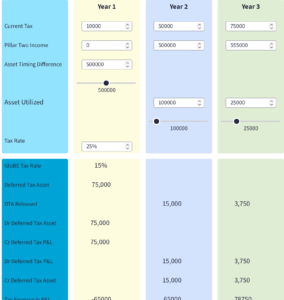Menu
Trending Now
Deferred tax is a key element of the Pillar Two rules.
It previously only impacted on the tax figures in the financial accounts, but under Pillar Two it has a direct impact on the effective tax rate, and therefore the top-up tax payable.
Deferred tax targets timing differences between the financial accounts and the tax computation. Without a deferred tax provision, a company could see its effective tax rate swing substantially from year to year.
As the effective tax rate is what the Pillar Two rules are based on, the deferred tax provision is essential to smooth out fluctuating effective tax rates.
It takes some accounting knowledge to understand the bookkeeping entries behind the deferred tax provision, however, a deferred tax asset (such as a tax loss carried forward) will result in a lower tax figure in the year the loss is incurred, and then a higher tax figure as the loss is utilized. The reverse applies to deferred tax liabilities (such as an immediate tax deduction where relief for financial accounting is over a number of years).
The Pillar Two rules further adjust the deferred tax provision in the financial accounts eg to take out deferred tax that relates to Pillar Two exempt income.
We have a lot of detailed information on deferred tax in our free analysis of deferred tax.
However, given its a relatively complex aspect of the Pillar Two rules we’ve put together this deferred tax asset calculator. It’s designed to show the impact of a deferred tax asset on the effective tax rate and top-up tax payable.
You can adjust the amount of the deferred tax asset and the amount that is utilized in years 2 and 3 to see how it operates. The tax rate is also important as this is used to measure the amount of the deferred tax asset. If the tax rate is above the 15% global minimum rate, it is recast to the 15% rate.
Please login or register to use the deferred tax asset calculator.

| Cookie | Duration | Description |
|---|---|---|
| cookielawinfo-checkbox-analytics | 11 months | This cookie is set by GDPR Cookie Consent plugin. The cookie is used to store the user consent for the cookies in the category "Analytics". |
| cookielawinfo-checkbox-functional | 11 months | The cookie is set by GDPR cookie consent to record the user consent for the cookies in the category "Functional". |
| cookielawinfo-checkbox-necessary | 11 months | This cookie is set by GDPR Cookie Consent plugin. The cookies is used to store the user consent for the cookies in the category "Necessary". |
| cookielawinfo-checkbox-others | 11 months | This cookie is set by GDPR Cookie Consent plugin. The cookie is used to store the user consent for the cookies in the category "Other. |
| cookielawinfo-checkbox-performance | 11 months | This cookie is set by GDPR Cookie Consent plugin. The cookie is used to store the user consent for the cookies in the category "Performance". |
| viewed_cookie_policy | 11 months | The cookie is set by the GDPR Cookie Consent plugin and is used to store whether or not user has consented to the use of cookies. It does not store any personal data. |